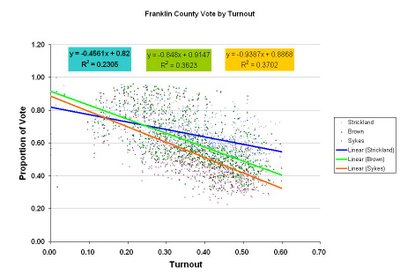Post-Mortem #2, Why We Tend to Lose
There are a lot of reasons that you always see the pattern displayed below, not the least of which is that the greater transience of folks in lower Socio-Economic brackets results in a greater number of 'abandoned' registrations in Dem precincts (this is what the folk on the right worry about in terms of fraud), leading to situations where registrations outnumber voters and perfect turnout is impossible.
But underneath it all, the effect is what it is. As Dem partisanship increases, turnout decreases. In 2004, you could see the GOTV effort in a big spike that occured when partisanship got up over 85% Dem. The rest of the line showed the old familiar negative slope.
The graph below shows Barbara Sykes's vote decreasing as turnout increases. It shows Sherrod Brown's vote decreasing at a slightly slower rate, with a fairly consistent 3 point advantage over Sykes. Strickland's line is much different. First of all, the regression line only gives us 2/3 as much information as Syke's and Brown's lines give us (meaning that the Strickland vote is less related to precinct turnout). Secondly, the slope is much less negative, meaning that as precincts display greater turnout (and Republican Partisanship), Strickland lost much less support than the other Dems shown here. So Strickland cruised by gaining more support in Republican territory, Brown won by getting smaller but more consistent increases in support across the board.
What the graph really shows, though, is that if we could get out voters in our solid neighborhoods the way the GOP does in theirs, we would win. Most every race, most every time.
No comments:
Post a Comment